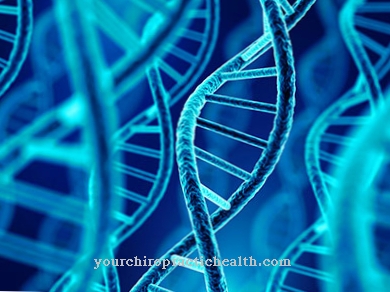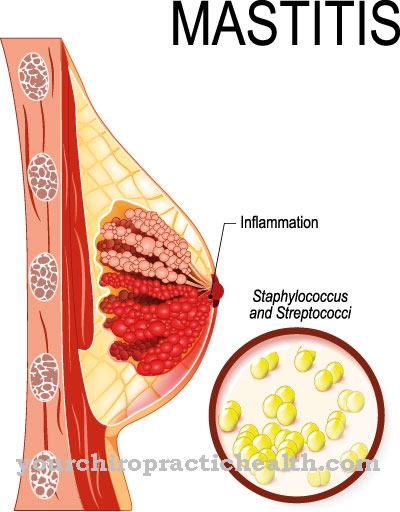At a Cholangitis or. Inflammation of the bile duct it is an infection of the bile duct. Typically, those affected suffer from fever, epigastric pain and jaundice. Treatment is usually carried out by giving antibiotics.
What is cholangitis?
.jpg)
Cholangitis is inflammation of the biliary tract. These canal-like structures are needed to transport the bile from the liver via the gallbladder to the duodenum. Toxins, among other things, are transported away in the bile. Their main task, however, is fat digestion.
Those affected typically suffer from severe pain in the upper abdomen, fever and jaundice, i.e. yellowing of the skin. Cholangitis is often accompanied by vomiting and discoloration of the stool.
A basic distinction is made between acute, purulent cholangitis, non-purulent cholangitis and sclerosing cholangitis. The different forms of cholangitis have different causes, but mostly lead to the same symptoms.
causes
Acute cholangitis is largely caused by bacteria. In many cases, the pathogenic bacteria originate from the small intestine, from which they invade the bile duct in an unexplained manner. In exceptional cases, viruses are responsible for the inflammatory reaction in the bile ducts.
The most common cause of inflammation of the biliary tract is the formation of gallstones. Above a certain size, these block the bile ducts and thus prevent the transport of the bile. Pathogens that cause an infection of the biliary tract can then easily settle in the blocked bile. To date, it is not known what causes chronic cholangitis.
Sometimes an autoimmune disease is assumed, in which the immune system recognizes and damages its own cells as foreign bodies. Rare causes of inflammation of the bile duct are tumors in the bile ducts, parasite infestation and diverticula. After operations on the liver, duodenum or the bile ducts themselves, narrowing can sometimes occur, which makes the development of bile duct inflammation easier. Genetically determined malformations of the bile ducts are very rarely the cause of cholangitis.
Symptoms, ailments & signs
- colicky pain in the upper abdomen
- Exhaustion
- fever
- Yellowing of the skin
- Yellowing of the eyes
- rarely blood poisoning
Diagnosis & course
A medical history is usually sufficient to diagnose acute cholangitis. During the consultation with the patient, the attending physician determines, among other things, how long the symptoms have existed and whether there are any risk factors such as obesity or gallbladder disease.
This is followed by the physical exam. If there is actually an inflammation of the bile ducts, the doctor can determine the so-called Charcot triad. It is a complex of three symptoms, namely fever, right-sided upper abdominal pain and jaundice. If these three symptoms occur together, the likelihood of cholangitis is very high.
A blood test is usually done to confirm the suspected diagnosis. If the bile duct is inflamed, the number of leukocytes is usually increased, which indicates an infection. Gallstones are diagnosed using an ultrasound scan. Sclerosing cholangitis can often be detected using antibodies in the blood.
The course of infection of the bile duct depends on the severity of the disease. If acute bile duct inflammation is diagnosed and treated quickly, a complete cure can be expected.
Complications
In most cases, complications only arise if the biliary tract infection is diagnosed too late or if treatment starts too late. The patient mainly suffers from pain in the upper abdomen and a general feeling of illness. The eyes and skin turn yellow and the affected person is no longer able to perform physical activities.
It can also lead to a very high fever. If the bile duct inflammation is left untreated, blood poisoning can also occur, which in the worst case leads to the death of the patient. In many cases there is also severe itching of the skin due to the biliary tract inflammation. Treatment is mostly done with the help of antibiotics and pain relievers.
If this starts early, there will be no further complications for the patient and the disease will subside after a few days. If gallstones have formed due to the inflammation of the bile duct, these must also be removed. Life expectancy is not reduced with successful treatment for biliary inflammation. However, it cannot be ruled out that the disease will recur in the course of life.
When should you go to the doctor?
Acute cholangitis requires a prompt visit to the doctor. This is quickly realized by those affected by the severe symptoms, as the sometimes severe pain is difficult to endure without medical treatment.
The other signs of inflammation of the biliary tract also make a doctor's visit necessary, as neither jaundice nor fever or chills are compatible with the ability to work and significantly reduce the quality of life of those affected. There are two other reasons for a quick visit to the doctor: On the one hand, the choalangits with all their unpleasant symptoms hardly ever resolve spontaneously without therapy. On the other hand, a visit to the doctor can protect against serious complications such as shock or massive effects on the patient's central nervous system or kidneys.
Because cholangitis is often associated with severe courses, it is justified to visit a doctor or a hospital even if there is a mere suspicion of this disease. Because the earlier the treatment starts, the quicker and more pleasant the medical help is often. This is why it makes sense to see a doctor for patients with chronic biliary problems or an accompanying illness, for example in the intestinal area. The first treatment for cholangitis does not have to be given by the attending physician, but can be in any emergency room.
Doctors & therapists in your area
Treatment & Therapy
To prevent serious complications such as sepsis, cholangitis needs medical attention as soon as possible. Since acute bile duct inflammation is usually caused by bacteria, antibiotics are used to treat it. Which antibiotic is prescribed by the doctor depends on the type of bacteria. Cephalosporin is often used.
An effective treatment of the infection is usually only possible if the affected person takes two different antibiotics at the same time. In the majority of cases, the patient's state of health improves within a few days after antibiotics are given. Since inflammation of the bile ducts is often very painful, painkillers can be used in addition to antibiotics. Particularly suitable are agents that also have an antispasmodic effect, as many people affected suffer from colic-like pain. If the fever is very high, antipyretic drugs must be taken to keep the body functioning properly.
If gallstones are the cause of the infection, they usually have to be removed. In many cases, the inflammation of the bile duct goes away on its own. In the event of a general disturbance of the flow of bile juice, a stent can be used, which has a support function for the bile duct. The goal of therapy is to restore the flow of bile. In the case of sclerosing cholangitis, this is hardly possible because the causes are unknown and therefore cannot be treated. In these cases, treatment consists of purely symptomatic therapy, which increases general well-being.
Outlook & forecast
Cholangitis has a favorable prognosis in adults with a stable immune system and no other diseases. The healing and permanent freedom from symptoms is linked to early treatment and therapy of the symptoms. With the use of medication, recovery from cholangitis is achieved in most cases within a few weeks. A recurrence of the disease is possible in principle, but is only rarely observed.
The prerequisite for healing of the biliary tract inflammation is the removal of any existing gallstones. These prevent the patient from recovering until they completely disappear. Without medical care, the patient's state of health can deteriorate significantly. In addition, there is a risk that the inflammation will change from a recurrent to a chronic course.
The longer the cholangitis remains untreated, the higher the risk of secondary diseases. Often there are changes in the biliary tract. In these patients, scarring and narrowing of the biliary tract can be expected. These complications worsen the prognosis and can lead to further illnesses. In severe cases, there is a risk of biliary backlog, liver cirrhosis and the development of bile duct cancer. This increases the patient's risk of shortening normal life expectancy. The healing process is generally delayed in patients with a weakened immune system.
prevention
It is not possible to specifically prevent cholangitis. Nevertheless, there are various measures that can significantly reduce the risk of developing acute biliary inflammation. Since gallstones are the most common cause of bile duct infection, they should be prevented. The best prophylactic measure is a healthy diet. A low-fat diet that is high in fiber is best. It is also important to drink enough fluids. The chronic form of cholangitis cannot be prevented.
Aftercare
In most cases, there are only a few follow-up measures available to those affected with inflammation of the bile duct. In the case of this disease, the person affected must first and foremost consult a doctor so that the symptoms do not worsen further or other complications occur. The earlier a doctor is consulted, the better the further course usually is, so that the person affected should contact a doctor at the first signs and symptoms of biliary inflammation.
Self-healing cannot occur. The disease itself is usually treated by taking antibiotics. It is always important to ensure the correct dosage and regular intake so that the symptoms are alleviated. It should also be noted that the antibiotics should not be taken together with alcohol, otherwise their effect will be weakened.
In children, parents must monitor and control the intake. Even after the treatment, further regular examinations by a doctor are very important in order to detect damage to the internal organs at an early stage. As a rule, the patient's life expectancy does not decrease if the bile duct inflammation is detected and treated in good time.
You can do that yourself
When the bile duct inflammation occurs, those affected feel very sick. Treatment should be quick to minimize the risk of consequential damage. Non-treatment or pure self-treatment can lead to a life-threatening condition. A strict bed rest is usually observed by itself.
Depending on the cause of the disease, it is advisable to combine prescribed antibiotic therapy with probiotic treatment of the intestine. In the acute stage, food should be avoided entirely in order to relieve the bile ducts. Later, the diet should be switched to light foods - also to relieve the liver, which is usually involved.
Sufficient intake of fluids is also beneficial for the recovery process. Still mineral water and unsweetened herbal teas should preferably be added. Even after a successful treatment, the liver is usually heavily stressed, so alcohol and fats should be avoided in the subsequent period.
If an autoimmune disease is the cause of the inflammation, it is important to constantly strengthen the immune system by avoiding stress, ensuring balanced relaxation, a balanced diet and regular exercise. Micronutrient therapy (selenium, minerals) has also proven to be beneficial for inflammatory processes.
Homoeopathically prepared Colocynth (C6), Magnesium phosphoricum (C6), Bryonia album (C6) or Chamomilla vulgaris (C6) can help against the pain in the acute stage of the disease, taken every hour.




.jpg)






















